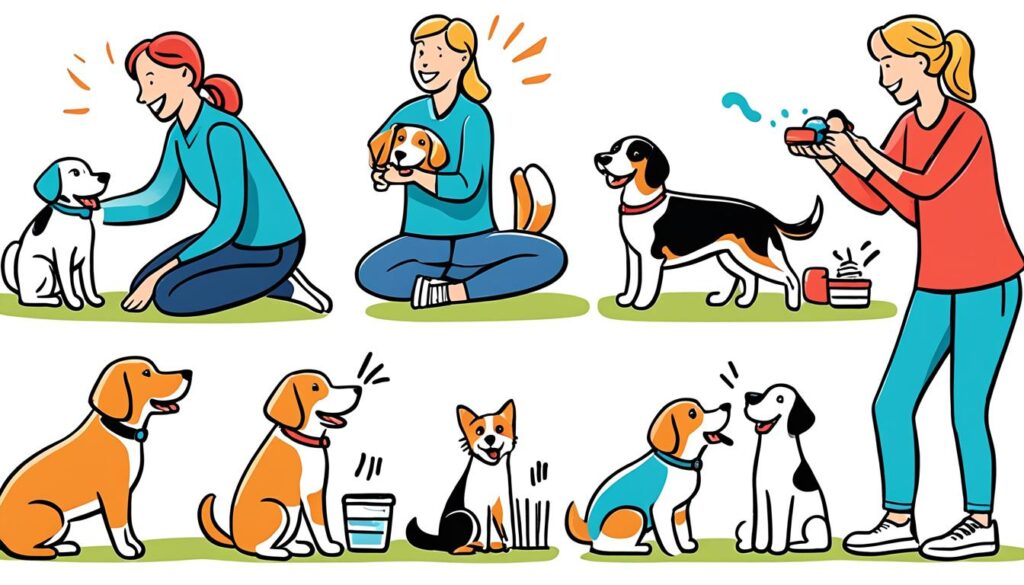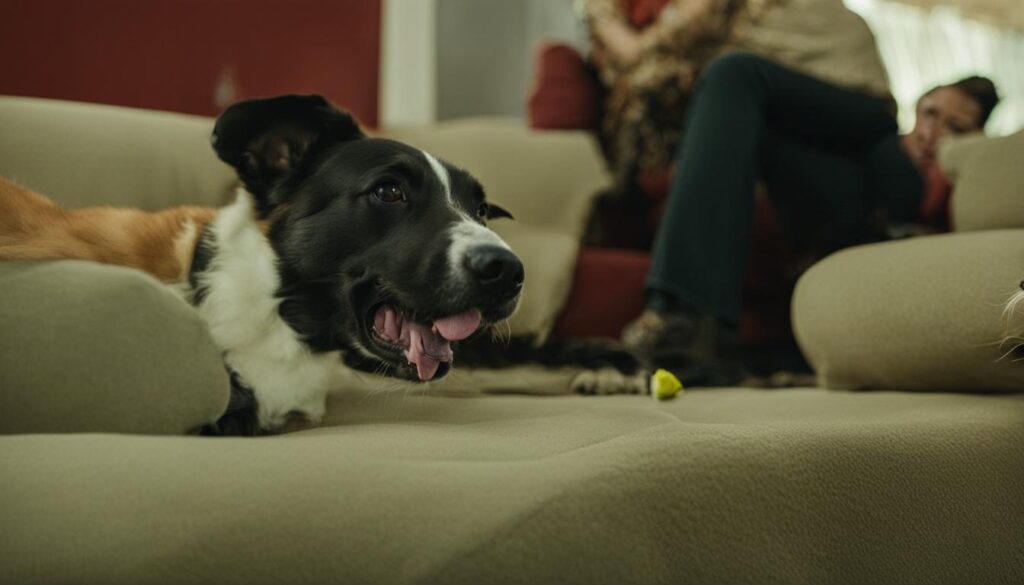Welcome to our comprehensive guide on training your pet using positive techniques. Whether you have a dog or a cat, training them for success is not only beneficial for their well-being but also strengthens the bond between you and your furry companion. In this article, we will explore a range of training methods, from housebreaking and leash training to obedience training and behavior modification, all centered around the principles of positive reinforcement. By adopting these techniques, you can achieve effective and lasting results while promoting a happy and harmonious relationship with your pet.
Key Takeaways
- Training your pet using positive reinforcement strengthens the bond between you and your furry companion.
- Housebreaking, leash training, obedience training, and behavior modification are all essential aspects of pet training.
- Positive reinforcement techniques focus on rewarding desired behaviors to achieve successful training outcomes.
- Understanding your pet’s body language and building trust through consistency and positive interactions are key to effective training.
- Incorporating fun, play, and mental stimulation into training sessions can elevate the training experience for both you and your pet.
Embracing the Positive Reinforcement Approach
In the world of pet training, positive reinforcement is considered one of the most effective and humane techniques. At its core, positive reinforcement training focuses on using rewards to motivate and shape desired behaviors in pets. By harnessing the power of motivation and positive feedback, this training philosophy creates an enjoyable and productive learning experience for both pets and their owners.
The Philosophy Behind Positive Reinforcement
Positive reinforcement training is rooted in the belief that animals, including our beloved pets, respond best to positive experiences and rewards. Instead of using punishment or coercion, this approach highlights the importance of reinforcing good behavior to encourage its repetition. By rewarding desired behaviors with treats, praise, or play, the training process becomes enjoyable and builds a strong bond between pet and owner.
When using positive reinforcement techniques, it is essential to understand the underlying principles of motivation. Pets are motivated by the desire to earn rewards, such as treats or affection, making them more willing to learn and engage in training activities. By tapping into this intrinsic motivation, positive reinforcement training creates a positive and fulfilling training experience for pets.
Reward Markers and their Impact on Training
One powerful tool in positive reinforcement training is the use of reward markers. Reward markers are distinct signals, such as a clicker sound or a verbal cue like “yes,” that indicate to the pet that they have performed the desired behavior and will receive a reward. These markers help pets understand which behaviors they should continue to perform and which ones will earn them a reward.
The effectiveness of reward markers lies in their ability to provide immediate feedback to the pet. They bridge the gap between the desired behavior and the reward, making the association clear and promoting faster learning. Reward markers also help maintain consistency in training sessions and enhance communication between pet and owner.
| Reward Markers | Impact on Training |
|---|---|
| Clicker Sound | Instantly signals the desired behavior and rewards the pet |
| Verbal Cue (e.g., “Yes”) | Provides a clear indication of the desired behavior and reinforces its repetition |
| Visual Cue (e.g., Hand Signal) | Offers a visual reference for the pet to associate with the reward |
Integrating reward markers into positive reinforcement training techniques adds precision and clarity to the training process. Pet owners can effectively communicate their expectations to their pets, resulting in faster learning, improved behavior, and a more satisfying training experience for both.
Training Your Pet for Success with Step-by-Step Techniques
When it comes to pet training, a step-by-step approach is key to achieving success. By breaking down the training process into manageable stages, you can effectively teach your pet new behaviors and ensure long-term obedience. In this section, we will guide you through the essential steps and techniques for training your pet.

Consistency is crucial when training your pet. Create a regular training schedule that includes short, focused sessions each day. Stick to the routine to help your pet understand what is expected of them and reinforce their learning.
2. Setting Goals:
Before you begin training, define clear goals for what you want your pet to learn. Whether it’s basic obedience commands or advanced tricks, having specific objectives will help you stay on track and track your pet’s progress.
3. Creating a Positive Training Environment:
Positive reinforcement is a powerful tool in pet training. Use treats, praise, and rewards to encourage desired behaviors and motivate your pet. Create a supportive and nurturing environment where your pet feels comfortable and eager to learn.
4. Behavior Modification:
Understanding and modifying unwanted behaviors is an important aspect of training. Identify any problematic behaviors and employ positive reinforcement techniques to redirect your pet’s behavior towards more desirable alternatives.
5. Obedience Training:
Teaching your pet basic obedience commands such as sit, stay, and come is essential for their safety and well-being. Break down these commands into small steps, reward your pet for success, and gradually build up their skills.
6. Training Methods:
There are various training methods you can explore, such as clicker training, target training, and shaping. Find the approach that works best for your pet’s individual needs and preferences.
By following these step-by-step training techniques, you can effectively train your pet and develop a strong bond built on trust and positive reinforcement. With consistency, patience, and dedication, you and your pet can achieve great results!
Understanding Your Pet’s Behavior for Effective Training
In order to train your pet effectively, it is important to have a deep understanding of their behavior. By interpreting their body language and building trust through consistent and positive interactions, you can communicate more effectively with your furry friend. This section will explore the key aspects of understanding your pet’s behavior and how it relates to successful training.
Interpreting Canine Body Language
One of the crucial skills for any pet owner is the ability to interpret their dog’s body language. Dogs communicate a lot through their body posture, facial expressions, and tail movements. By paying attention to these cues, you can gain insights into your dog’s emotional state, intentions, and whether they are comfortable or stressed in a particular situation.
For example, a relaxed and loose body posture typically indicates that your dog is calm and at ease. On the other hand, a stiff body posture and raised hackles may indicate fear, aggression, or discomfort. By recognizing these signals, you can adjust your training approach accordingly and provide the necessary support and reassurance to your dog.
Building Trust Through Consistency and Positive Interactions
Building trust is essential for effective training and creating a strong bond with your pet. Consistency is key when it comes to training your pet. By establishing clear rules and expectations, and consistently enforcing them, you can create a predictable and stable environment that your pet can rely on.
Positive interactions play a crucial role in building trust with your pet. By using positive reinforcement techniques, such as praise, treats, and play, you can motivate your pet to engage with you and learn new behaviors. Consistently rewarding desired behaviors helps your pet understand what is expected from them, reinforcing positive outcomes and strengthening the bond between you.
Effective communication, built on trust, consistency, and positive interactions, is the foundation of successful training. By understanding your pet’s behavior and responding appropriately, you can enhance the effectiveness of your training sessions and establish a harmonious relationship with your furry companion.
Essentials of Obedience Training
In obedience training, teaching your pet basic commands is essential for their overall behavior and manners. By using positive reinforcement techniques, you can effectively communicate with your pet and instill the desired behaviors. Let’s explore the basic commands that are fundamental to obedience training:
Sit: Teaching your pet to sit on command is the first step in obedience training. This command establishes control and helps prevent impulsive behaviors. Use treats or verbal praise as positive reinforcement to reward your pet for sitting when commanded.
Stay: The “stay” command teaches your pet to remain in a specific position until given permission to move. This command is crucial for their safety and also helps in situations where you need your pet to hold their position, such as when visitors arrive or during mealtimes.
Come: The “come” command is essential for recall and ensuring your pet comes to you when called. It is crucial for their safety and allows you to maintain control in various situations, such as when off-leash or during unexpected circumstances.
Leave It: Teaching the “leave it” command prevents your pet from picking up or engaging with items that are potentially dangerous or inappropriate. This command helps keep them safe and encourages them to focus on you instead of distractions.
To effectively teach these commands, use positive reinforcement such as treats, verbal praise, and affection. Consistency, patience, and short training sessions are key to successful obedience training. Remember, each pet is unique, so adapt your training techniques to suit their individual needs and temperament.

Housebreaking Strategies That Work
Housebreaking, also known as potty training, is an essential part of bringing a new pet into your home. Establishing a routine and setting boundaries are key components of successful housebreaking. By implementing these strategies, you can accelerate the house training process and create a positive environment for your pet.
Creating a routine is crucial for housebreaking your pet. Consistency is key, so it’s important to establish a set schedule for feeding, bathroom breaks, and exercise. By providing your pet with a predictable routine, you help them understand when and where they should relieve themselves.
Setting boundaries is equally important during the housebreaking process. Designate a specific area in your home where your pet is allowed to go potty. This could be a patch of grass in your yard or a litter box for cats. By consistently taking them to this designated area, you reinforce the idea that this is the appropriate place for bathroom behavior.
Positive reinforcement is a powerful training method that can enhance the effectiveness of housebreaking. When your pet successfully eliminates in the designated area, praise and reward them with treats or verbal encouragement. This establishes a positive association with the desired behavior and motivates your pet to repeat it.
There are several proven methods for accelerating house training. One popular technique is crate training, where your pet is confined to a crate or a small designated space when they are not supervised. This teaches them to hold their bladder and bowels until they are taken outside or to their designated potty area.
Another effective method is to establish a consistent command or cue when it’s time for your pet to go potty. By using a specific word or phrase, such as “go potty” or “do your business,” you can train your pet to associate that command with the desired behavior. This makes it easier to communicate your expectations and prompts your pet to eliminate on command.
By incorporating these housebreaking strategies into your training routine, you can effectively teach your pet where and when to go potty. Remember to be patient, consistent, and provide positive reinforcement throughout the process. With time and consistent effort, your pet will become successfully housebroken, leading to a harmonious and stress-free living environment.
Fun with Tricks: Engage Your Pet through Clicker Training
Clicker training is a popular and rewarding method of training your pet that utilizes positive reinforcement. It’s a fun way to teach your pet a variety of tricks, keeping them mentally stimulated and strengthening the bond between you and your furry friend.
Using a clicker, which is a small handheld device that makes a distinct clicking sound, you can mark and communicate to your pet when they exhibit the desired behavior. This clear and instant feedback helps your pet understand which actions are being rewarded, making the training process more effective.
With clicker training, the possibilities are endless. You can teach your dog to roll over, play dead, or even jump through hoops. For cats, clicker training can involve tricks like giving a high-five, jumping through a hoop, or even using a toilet!
“Clicker training builds communication and trust between you and your pet, resulting in a harmonious relationship.”
One of the key benefits of clicker training is that it encourages mental stimulation. By engaging your pet in learning new tricks, you stimulate their cognitive abilities and prevent boredom. This mental exercise is just as important as physical exercise for their overall well-being.
Whether you have a dog or a cat, clicker training can be a highly effective way to teach them new tricks and behaviors. It empowers you as a pet owner to take an active role in their training while using positive reinforcement techniques.
So grab a clicker, some tasty treats, and get started on this exciting training journey with your pet!
Leash Training: Fostering a Bond on Walks
Leash training is an essential aspect of pet ownership that not only ensures your pet’s safety but also strengthens the bond between you and your furry companion. By promoting proper leash etiquette and incorporating exercise into your walks, you can create a positive training experience for both you and your pet.
Promoting Proper Leash Etiquette
Proper leash etiquette is crucial for enjoyable and stress-free walks. It involves teaching your pet to walk calmly on a leash without pulling or lunging. To achieve this, start by using a leash that is appropriate for your pet’s size and strength. Ensure that the leash is neither too long nor too short, allowing for comfortable movement while maintaining control.
Begin the training process in a quiet and familiar environment, such as your backyard or a quiet park. Use positive reinforcement techniques, such as treats and praise, to reward your pet for walking calmly by your side. Consistency is key, so be patient and persistent in reinforcing proper leash behavior.
Additionally, practice leash greetings with other dogs and people. Teach your pet to approach calmly and politely, avoiding any leash tugging or aggressive behavior. This will help create a harmonious walking experience and foster positive social interactions for your pet.
Exercise as a Base for Successful Leash Training
Exercise plays a vital role in successful leash training. Regular physical activity helps your pet release pent-up energy, reduces anxiety, and promotes overall well-being. Before starting your leash training session, engage in a brief play or exercise session with your pet to encourage focus and minimize distractions.
During walks, allow your pet time to explore their surroundings while maintaining a controlled and relaxed pace. Provide opportunities for mental stimulation by incorporating nose work activities, such as sniffing games and searching for treats along the route. This helps keep your pet engaged and mentally fulfilled during walks.
Remember to adjust the duration and intensity of your walks based on your pet’s age, breed, and fitness level. Gradually increase the distance and difficulty of your walks as your pet becomes more comfortable and proficient in leash training.
By prioritizing proper leash etiquette and incorporating exercise into your walks, you can create a positive and enjoyable experience for both you and your pet. Leash training not only ensures your pet’s safety but also strengthens the bond between you, leading to countless rewarding adventures together.

Addressing Common Behavioral Challenges
At times, pet training can present various behavioral challenges that pet owners may find overwhelming. However, with the right techniques and a positive reinforcement approach, these challenges can be effectively managed and modified. In this section, we will provide you with tips and strategies to address common behavioral challenges in your pets, be it dogs or cats.
Behavioral challenges encompass a wide range of issues such as excessive barking, aggression, separation anxiety, destructive behavior, and leash pulling. We understand that these challenges can disrupt the harmony in your home and hinder your pet’s overall well-being. That’s why it is essential to approach these challenges with patience, consistency, and positive reinforcement.

One effective method for addressing behavioral challenges is behavior modification. This technique focuses on identifying the underlying causes of the unwanted behavior and implementing positive strategies to modify it. By understanding the root cause, we can address the problem at its source, leading to long-term solutions and improved behavior.
Positive reinforcement plays a crucial role in behavior modification. Instead of punishing or scolding your pet for unwanted behavior, focus on rewarding and reinforcing positive behaviors. This approach encourages your pet to repeat desirable actions, helping them overcome behavioral challenges through positive associations.
Problem-solving is another essential aspect of addressing behavioral challenges. Analyze the specific situation and problem your pet is facing, and then develop a tailored plan to address it. This may involve providing alternative outlets for their energy, creating a calming environment, or seeking professional guidance through a certified animal behaviorist or trainer.
Remember, addressing behavioral challenges takes time and consistent effort. Each pet is unique, and their progress may vary. With patience, positive reinforcement, and problem-solving techniques, you can effectively address and overcome common behavioral challenges, creating a happier and healthier bond with your pet.
Continue reading to discover advanced techniques in the next section, where we explore how to take your pet’s training to the next level by incorporating fun and play into daily training sessions.
Advanced Techniques: Taking Training to the Next Level
Now that you’ve mastered the basics of pet training, it’s time to take it to the next level. Advanced training techniques can help challenge your pet mentally and provide even more opportunities for growth and learning. In this section, we will explore how to incorporate fun and play into your daily training sessions and how to master complex commands for enhanced mental stimulation.
Incorporating Fun and Play into Daily Training Sessions
Training should be an enjoyable experience for both you and your pet. By incorporating fun and play into your daily training sessions, you can make the process more engaging and rewarding. One way to do this is by using interactive toys or puzzle games that require your pet to use their problem-solving skills. These toys provide mental stimulation while reinforcing training commands.
Additionally, you can introduce games and activities that stimulate your pet’s natural instincts. For example, if you’re training a dog, you can play fetch or hide and seek to reinforce commands such as “sit” and “stay.” For cats, try using interactive wand toys or laser pointers to encourage them to chase and pounce, while still reinforcing their training commands.
Remember to keep training sessions short and end on a positive note, using plenty of praise and rewards. By making training fun and playful, you will keep your pet motivated and eager to learn.
Mastering Complex Commands for Enhanced Mental Stimulation
Teaching your pet complex commands not only challenges their cognitive abilities but also provides them with a sense of accomplishment. These advanced commands go beyond basic obedience training and require your pet to think critically and execute precise actions.
Start by breaking down complex commands into smaller, more manageable steps. This allows your pet to understand and master each component before moving on to the next. Use positive reinforcement techniques, such as clicker training or rewards, to motivate and encourage your pet during the learning process.
Some examples of complex commands include “roll over,” “play dead,” or “fetch specific objects.” These commands require your pet to perform multiple actions and follow more detailed instructions. With patience, consistency, and plenty of praise, your pet will soon be able to master these impressive feats.
Remember, advanced training techniques require time and dedication. Be patient with your pet, and celebrate their progress along the way. By challenging them mentally and incorporating fun into their training, you can strengthen the bond between you and your furry companion while continuing to foster their growth and development.
Conclusion
In conclusion, positive training methods offer lifelong benefits for both pet owners and their furry companions. By focusing on positive reinforcement, we can create a training environment that fosters trust, strengthens the bond between pet and owner, and brings about lasting behavior change.
The training journey doesn’t end once basic commands and housebreaking are mastered. It is an ongoing process that requires patience and dedication. By continuing to train our pets with joy and enthusiasm, we can deepen our connection and enjoy a harmonious relationship based on mutual understanding.
Whether you’re training a dog or a cat, positive reinforcement remains the cornerstone of successful training. It encourages good behavior, enhances mental stimulation, and promotes a positive atmosphere in your home. By employing these methods, you can shape your pet into a well-behaved and happy companion.
FAQ
What is positive reinforcement training?
Positive reinforcement training is a training method that uses rewards to motivate and shape desired behaviors in pets. It focuses on rewarding good behaviors rather than punishing bad behaviors.
How does positive reinforcement training work?
Positive reinforcement training works by associating rewards, such as treats or praise, with desired behaviors. This encourages pets to repeat those behaviors in order to receive the reward.
What are reward markers, and how do they enhance training effectiveness?
Reward markers, such as a clicker or a specific word, signal to your pet that they’ve performed the desired behavior and that a reward is coming. They help to communicate and reinforce the desired behavior, making the training process more efficient and effective.
How do I establish a training routine for my pet?
To establish a training routine for your pet, set aside regular, consistent training sessions each day. Keep the sessions short and enjoyable, focusing on one command or behavior at a time.
How do I set goals for my pet’s training?
When setting goals for your pet’s training, start with simple, achievable objectives and gradually work towards more complex behaviors. Keep the goals realistic, considering your pet’s age, breed, and individual capabilities.
How can I create a positive training environment for my pet?
To create a positive training environment, use a quiet and distraction-free space. Have plenty of treats or rewards readily available, and make sure you and your pet are both in a calm and positive mindset.
Why is it important to understand my pet’s behavior during training?
Understanding your pet’s behavior is crucial for effective training. By interpreting your pet’s body language, you can gauge their emotional state and intentions, adapt your training approach accordingly, and address any potential challenges or fears they may have.
How can I interpret my canine’s body language during training?
When interpreting your canine’s body language, look for signs of relaxation, engagement, and focus. Watch for subtle cues such as tail wagging, eye contact, and relaxed body posture, which indicate receptiveness to training.
How do I build trust with my pet through consistency and positive interactions?
Building trust with your pet involves being consistent in your training methods and offering positive interactions. Be patient, reward good behaviors, and avoid using punishment or force, as this can damage the trust and hinder the training process.
What are some essential commands to teach my pet during obedience training?
Some essential commands to teach your pet during obedience training include sit, stay, come, and leave it. These commands help to establish control, improve safety, and enhance communication between you and your pet.
How can I effectively housebreak my pet?
To effectively housebreak your pet, establish a routine that includes regular potty breaks, reward desired bathroom behaviors, and manage their environment to prevent accidents. Consistency, positive reinforcement, and patience are key to successful housebreaking.
What are some proven methods for accelerating house training?
Some proven methods for accelerating house training include crate training, using a designated potty area, establishing a consistent schedule, and closely monitoring your pet’s behavior and cues.
How can I engage my pet mentally through clicker training?
Clicker training can be used to teach a variety of tricks that provide mental stimulation for your pet. By associating the clicker with rewards, you can shape desired behaviors and encourage problem-solving skills in a fun and interactive way.
What are some tips for leash training my pet?
To leash train your pet, promote proper leash etiquette by using positive reinforcement, keeping the leash loose, and rewarding your pet for walking politely. Regular exercise and bonding during walks are also essential for successful leash training.
How can positive reinforcement and behavior modification help address common pet behavioral challenges?
Positive reinforcement and behavior modification techniques can help address common pet behavioral challenges by rewarding desired behaviors and redirecting or modifying undesirable ones. This approach encourages your pet to make positive choices and leads to a more harmonious relationship.
What are some advanced techniques to enhance my pet’s training?
To enhance your pet’s training, incorporate fun and play into daily sessions to keep them engaged and motivated. Mastering complex commands and tricks can provide mental stimulation and strengthen the bond between you and your pet.
Source Links
- https://domorewithyourdog.com/DogTricks/product/the-joy-of-dog-training-new/
- https://www.quarto.com/books/9781631599705/the-joy-of-dog-training
- https://brendaaloff.com/shop

